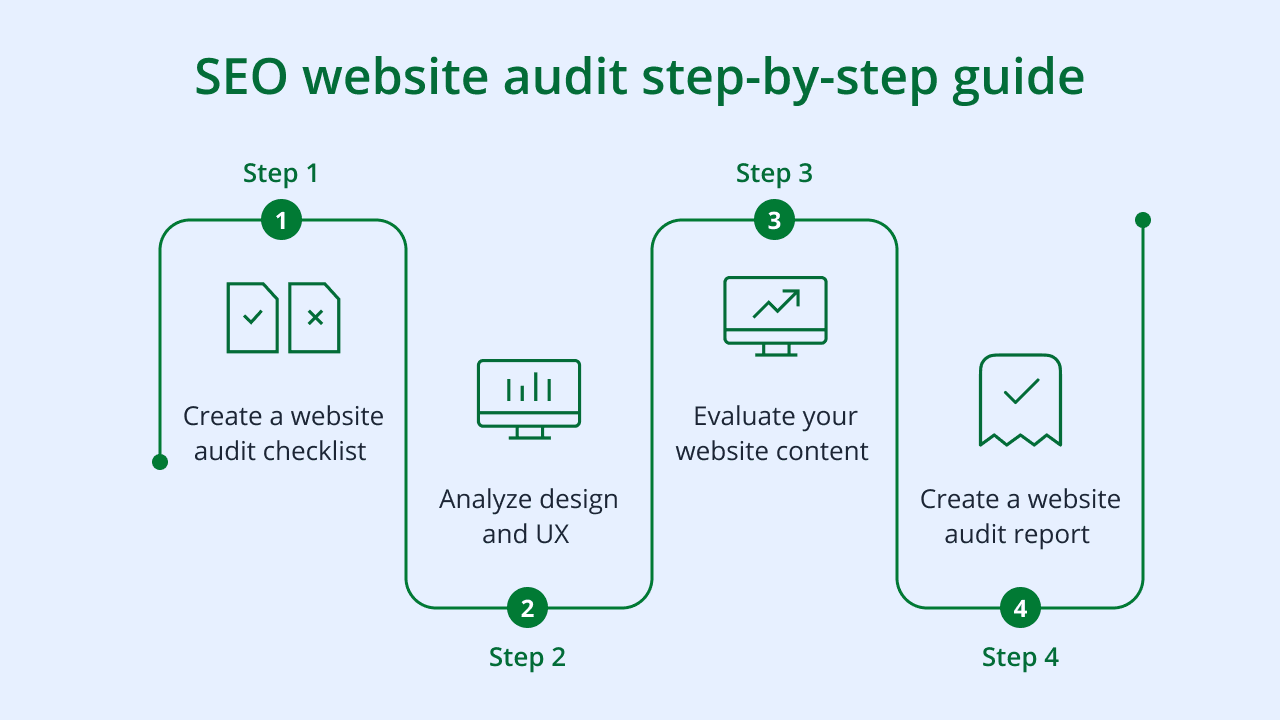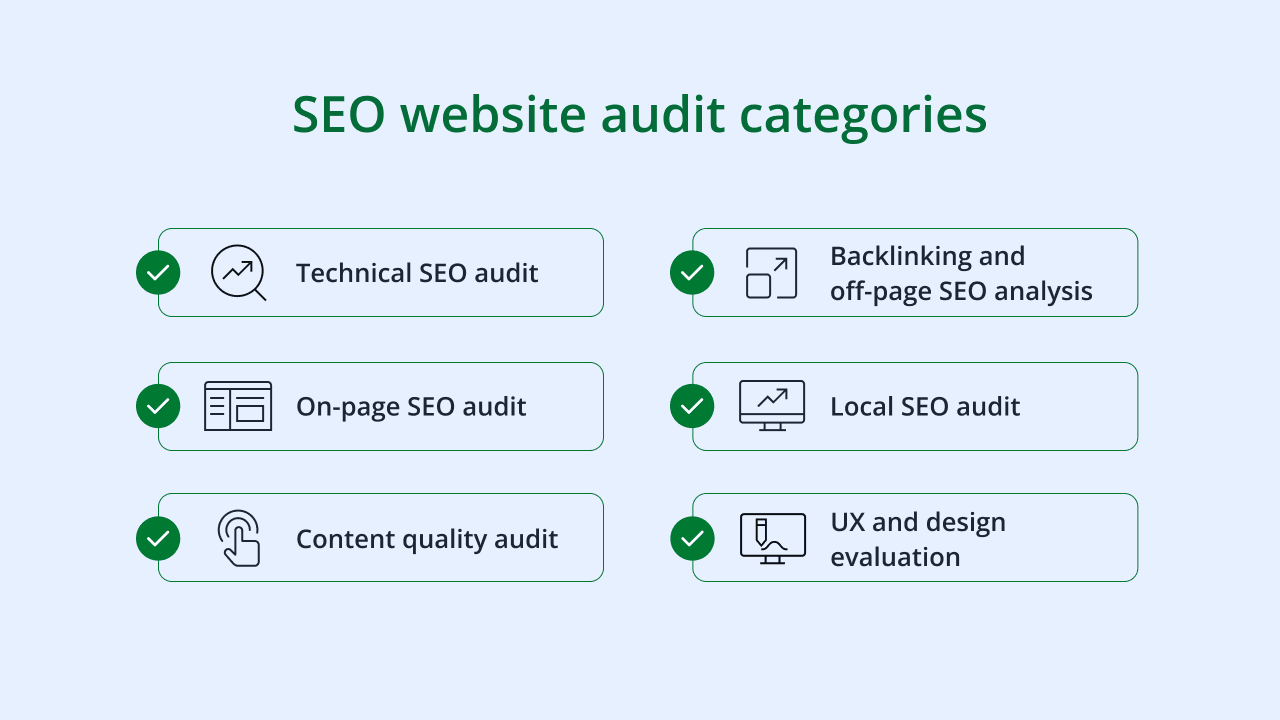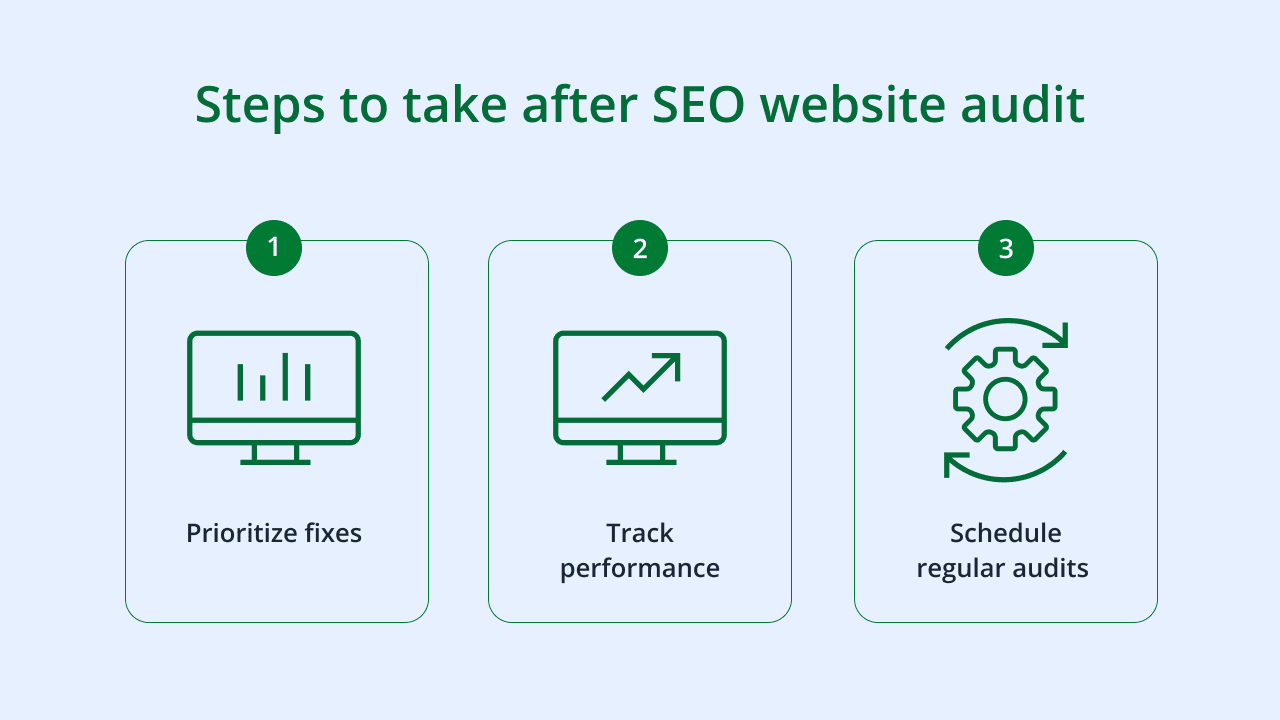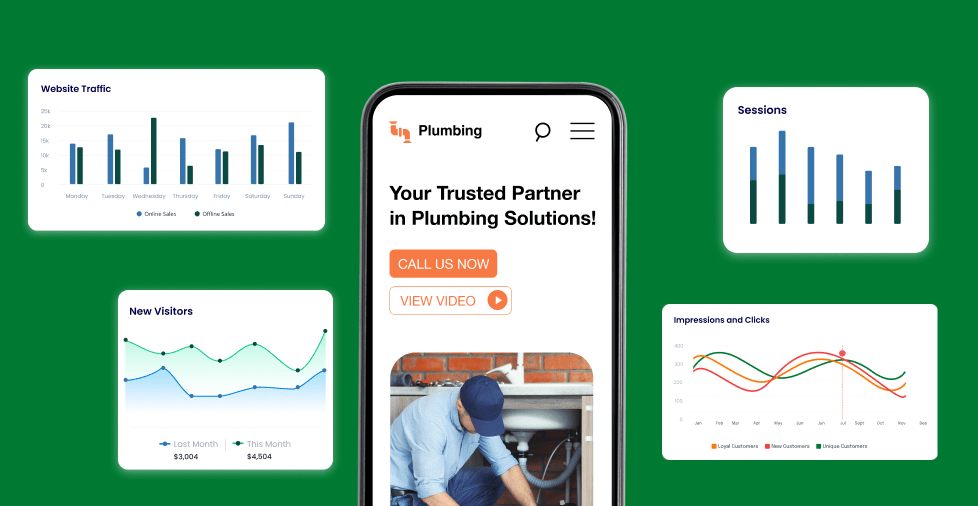Key takeaways:
- An SEO website audit evaluates a site’s performance extensively to identify issues and opportunities to improve visibility and functionality.
- SEO audits focus on areas like search performance, user experience, technical health, and competitive analysis to improve rankings and engagement.
- Doing regular SEO website audits is important for long-term success because they help you adapt to evolving search engine algorithms and user behaviors.
A beautiful website entices users to explore what you offer. But you can’t only focus on making your website look great; you should also check if it’s properly optimized.
How do you do that? The answer is through a comprehensive Search Engine Optimization (SEO) website audit.
This guide will help you understand how an SEO website audit can uncover and resolve your website issues, enhance your SEO rankings, and provide a smooth user experience.
What is an SEO website audit?
An SEO website audit is a process that involves evaluating your site’s performance, user experience, and technical elements. It helps you identify and resolve problems affecting your online visibility, functionality, and engagement to increase organic traffic and keep your website competitive.
Why are website audits important?
Conducting a website audit is more than just about fixing issues such as slow-loading pages, broken links, or outdated content that can negatively affect your website’s performance.
It’s a strategic move to keep your website operating at its peak potential. Here are some of the areas of your website that can benefit from regular website audits:
- SEO performance
- User experience (UX)
- Technical health
- Competitive edge
SEO performance
Performing a website audit helps your site align with search engine algorithms so more people can find you online.
It gives you a detailed insight into your performance based on the following aspects: on-page SEO, off-page SEO, and technical SEO. By addressing them, you can outperform competitors, drive conversions, and increase rankings.
User experience (UX)
A website audit also helps you fix user experience issues or how your site interacts with visitors. It helps enhance your website, helping it load faster, which makes it mobile-friendly and easy to navigate.
Remember, your website’s UX plays an important role in keeping your visitors engaged with your website, converting them into customers.
Technical health
Conducting a technical audit helps you point out issues that may not be visible.
Note that your website’s back end is the foundation of its performance. It will help you inspect the robustness of your site’s technical framework and infrastructure.
Competitive edge
Doing a website audit will help you stay ahead in the competitive digital market.
An optimized website helps you track your competitor’s performance and online strategy, helping you see what opportunities your brand could be missing out on.
A comprehensive study of your website and competitors’ performance (speed, SEO usability, and content) can also help you understand where you stand.
It allows you to see what’s working for other companies in your market to integrate those tactics into your website strategy.
Lastly, a well-maintained and optimized website establishes trust with users and search engines. This also shows that your website produces relevant content.

How to perform an SEO audit

Follow these steps to perform a website audit effectively:
- Step 1. Create a website audit checklist
- Step 2. Analyze design and UX
- Step 3. Evaluate your website content
- Step 4. Create a website audit report
Step 1. Create a website audit checklist
Create a comprehensive audit checklist that will serve as your guide at each stage. The checklist should cover important categories, such as:
- Technical SEO
- On-page SEO
- Content
- Backlinking
- UX design
The checklist should also include a technical website audit so you can identify underlying issues that could be affecting your site’s performance. Utilizing a structured approach will help you address important aspects systematically.
Step 2. Analyze design and UX
How does the website design work for your visitors and customers? Some software programs have visual representations that help you identify which parts of the site design attract the most attention.
This analysis helps communicate how the overall design and user design impact visitors.
Step 3. Evaluate your website content
Content directly impacts how search engines interpret, index, and rank your website. High-quality, relevant content engages visitors and meets their search purpose. This causes your website to display prominently in search results.
Your content should be useful and captivating. Consider the following tips to make sure you’re offering great content to your audience:
- Remove duplicate write-ups
- Fix spelling and punctuation issues
- Keep your articles current
When assessing website content, it’s also important to check for keyword cannibalization risks that may cause certain pages to get stuck in low search results positions.
Step 4. Create a website audit report
After checking the important elements of your site, create a website audit report to help you strategize and implement changes in your site.
A website audit report will help you identify as well as fix issues in your website, keeping it performing and in high condition.
Here are some free audit tools you can use:
| Audit Tool | Function |
|---|---|
| Google Analytics | Helps you track web traffic, user behavior, and conversions |
| Google Search Console | Provides valuable data like clicks, impressions, and click-through rates |
| Google PageSpeed Insights | Assesses your site speed on desktop and mobile devices |
| Google Mobile-Friendly Test | Helps you check whether your site is mobile-friendly Note: Mobile friendliness became a priority after Google announced its switch to mobile-first indexing. |
The key website audit categories

Here are some key categories or website audit checklists to consider when performing a website audit:
- Technical SEO audit
- On-page SEO audit
- Content quality audit
- Backlinking and off-page SEO analysis
- Local SEO audit
- UX and design evaluation
Technical SEO audit
A technical SEO audit is focused on checking for any issues that could impact your website’s ranking in search engines. This involves problems like slow speed performance, duplicate content, and security issues.
How to perform a technical SEO audit:
- Fix broken links
- Optimize for mobile
- Improve page speed
- Verify HTTPS compliance
- Enhance Core Web Vitals
Fix broken links
Search engines need to crawl and index your site effectively. A website audit helps you identify crawl errors, broken links, 404 errors, and missing sitemaps that block search engines from accessing your content.
Leverage tools like Screaming Frog to look for the said issues and make the necessary changes afterward.
Optimize for mobile
62.54% of worldwide website traffic comes from mobile devices, according to recent data from Statista.
Google now utilizes mobile-first indexing for all websites. For these reasons, mobile compatibility is no longer optional, but necessary.
A website that smoothly adjusts to all devices provides a better user experience and can help you perform better in search rankings.
Use Google’s Mobile-Friendly Test to help you identify and resolve issues that prevent your website from functioning smoothly on mobile devices.
Improve page speed
When your website loads quickly, it reduces bounce rates and engages visitors. Meanwhile, a slow site can lead to a bad customer experience, costing you potential leads.
Improving site speed involves optimizing images, enabling cache, and compressing code to enhance loading times.
Verify HTTPS compliance
Search engines constantly evolve and update their algorithms to ensure a seamless user experience. Conducting a website audit will help you check for algorithm compliance, such as:
- Mobile-friendliness
- HTTPS security
- Fast load times
Enhance Core Web Vitals
Google’s Core Web Vitals are metrics that measure how users experience your website’s performance. Each metric represents a specific part of the user experience and reflects real-world outcomes. The three primary metrics are:
- Largest Contentful Paint (LCP). This measures loading performance, and a good score is 2.5 seconds or less.
- Interaction To Next Paint (INP). This gauges responsiveness, with a good score being less than 200 milliseconds.
- Cumulative Layout Shift (CLS). This measures visual stability, and a good score is less than 0.1.
To check how your website performs with these metrics, you can use tools like Google’s PageSpeed Insights (PSI). PSI gives you field data, which is based on real-world user experiences, and lab data, which comes from a simulated environment.
This combination offers a comprehensive view of your site’s performance and clear recommendations to help you fix any issues.
On-page SEO audit
An on-page SEO audit refers to making sure that the front-end and back-end elements of a page are optimized for search crawlers. This includes checking website copy, blog posts, and more.
What to check during an on-page SEO audit:
- Keywords
- Title tags and meta descriptions
- Image alt texts
- Internal linking
- Pillar pages
Keywords
A website audit guarantees that your pages are optimized with the right keywords in titles, headers, and content to match user intent. However, avoid keyword stuffing because this can lead to penalties.
Don’t know how to look for valuable keywords? Check out our article on finding good keywords to help you with your research.
Title tags and meta descriptions
These elements are your website’s “first impression” in search results. Be sure that they’re concise and include target keywords to boost CTR.
For the best results, keep meta title tags to 55 to 60 characters and meta descriptions to 155 to 160 characters.
Image alt texts
Using descriptive alt texts improves accessibility for visually impaired users. Alt texts also help search engines understand your content better.
Internal linking
Strong internal linking helps establish a hierarchy for your website. It helps search engines navigate and index your site efficiently. Plus, it improves user navigation, keeping visitors engaged.
Pillar pages
Pillar pages are landing destinations on your site that focus on broad topics, resources, products, or service areas. They help users and search engines access topically relevant content quickly.
Content quality audit
Your website’s content is the lifeline of your website. A content quality audit helps you systematically check the content produced on your website.
This process ensures your website content remains relevant, engaging, and aligned with your audience’s needs.
How to conduct a content audit:
- Identify outdated or low-performing pages
- Refresh or rewrite old content
- Incorporate keywords
- Enhance readability
Identify outdated or low-performing pages
For this process, you can use tools such as Google Analytics, SEMrush, or ContentKing to locate pages with low traffic, high bounce rates, or minimal engagement. These are the pages that need to be refreshed or overhauled.
Refresh or rewrite old content
In refreshing or rewriting old content, you can start by updating information, where you can add new data, trends, or case studies to an outdated post.
Incorporate keywords
Start incorporating keywords and align your content with modern user intent. Google Keyword Planner, Semrush, or Ahrefs can help you identify relevant phrases.
Enhance readability
Improve your content format by adding bullet points, visuals, and updated CTAs for enhanced readability.
Consider professional tools or services to help you perform a comprehensive and detailed content quality audit.
Backlinking and off-page SEO analysis
Off-page SEO involves building your website’s credibility and authority through external means to increase your online presence. This includes:
- Earning backlinks from authoritative websites
- Gaining mentions and citations
- Leveraging social media platforms
How to audit backlinks:
- Check backlink quality
- Remove toxic backlinks
- Optimize anchor texts
- Analyze competitors’ backlinking strategy
Check backlink quality
Assess your backlink profile using a site audit tool, such as Ahrefs and SEMrush. These tools help identify high-authority links that improve your rankings and low-quality links that can damage your reputation.
Remove toxic backlinks
Toxic backlinks often come from spammy or irrelevant websites. Use Google’s Disavow Tool to notify search engines to discard these links.
Optimize anchor texts
Make sure anchor texts are varied, relevant, and natural. Overusing exact-match anchors can signal manipulation and hurt your rankings.
Analyze competitors’ backlinking strategy
Study competitors’ backlink strategies to discover potential link-building opportunities. Target authoritative domains for partnerships or content collaborations.
Local SEO audit
For any business with a physical location, a local SEO audit is an important step to boosting your visibility in local search results. This process helps you identify where your business stands and what you can do to attract more local customers.
How to audit local SEO
- Be sure your Google Business Profile is updated.
- Make sure your business’ name, address, and phone number (NAP) are the same across all websites.
- Check if local citations are showing your current NAP information.
For a deeper dive into improving your local presence, check out our comprehensive guide on local SEO services.
UX and design evaluation
A smooth and intuitive user experience directly impacts engagement, conversion rates, and retention. UX also indirectly affects search rankings, which influences metrics like time on site and bounce rate.
What to evaluate in UX and design:
- Intuitive navigation
- Clear CTAs
- Bounce rate factors
- Accessibility
Intuitive navigation
Check if you have an easy-to-use navigation menu and a logical site structure. These will enhance UX for visitors by helping them easily find what they want.
Clear CTAs
Make sure calls-to-action (CTAs) stand out. Use clear wording and strategic placement. Whether you use “Buy Now” or “Contact Us,” they should guide users to act.
Bounce rate factors
Verify if you have intrusive ads, slow-loading pages, or cluttered layouts. These are factors that can contribute to high bounce rates.
Accessibility
Making your website accessible means designing it so everyone can use it, including people with disabilities. Creating an accessible site benefits your business by showing that you care about providing a good experience for all visitors.
You can make your website more accessible by checking a few key elements:
- Alt texts. An alt text describes the image and allows screen readers to explain it to visitors who can’t see it. Make sure your alt texts are as descriptive as possible.
- Keyboard navigation. Many people with motor disabilities navigate the web using only their keyboard. A well-designed site should allow users to easily tab through all interactive elements like links, buttons, and forms.
- Color contrast. Be sure there’s enough contrast between texts and background colors to make it easy for people with low vision to read the content.
Using audit results for ongoing improvement

Conducting a site audit is the first step in maintaining and improving your website performance. Its value depends on maximizing its results to enhance your website’s performance.
Once you’ve identified the issues through a website audit checklist, follow these next steps:
- Step 1. Prioritize fixes
- Step 2. Track performance
- Step 3. Schedule regular audits
Step 1. Prioritize fixes
Address the most serious issues, such as broken links or slow pages. Fixing broken links identified in your audit checklist helps you resolve 404 errors and maintain SEO health.
Next, make sure to verify HTTPS compliance to safeguard user data and maintain trust. Then, follow through with:
- Optimizing metadata
- Refreshing outdated pages
- Reassessing internal linking to improve site navigation and crawlability
Spotting and fixing the said issues can take time and effort from certain individuals: SEO analysts, content writers, and web developers.
Step 2. Track performance
Monitor the improvements you have integrated based on your site audit result. Consider using Google Analytics and Google Search Console at this stage.
These tools will help you:
- Monitor metrics
- Track the performance of recently optimized pages
- Identify crawl and indexing errors
Don’t forget to measure improvements in search queries to validate the effectiveness of changes made post-audit.
Step 3. Schedule regular audits
Making a one-time audit is not enough. Websites evolve, and so do user behavior and search engine algorithms.
You should conduct a regular site audit every six to 12 months. This frequency can help you maintain a healthy, competitive, and up-to-date website.
Why regular website audits are the key to long-term success
Website audits are necessary for long-term growth, SEO success, and user satisfaction. Identify and address hidden issues to make sure your site stays competitive and continues delivering value to your audience.
Don’t wait! Start your SEO website audit today, and unlock your site’s full potential. Use our Website Grader to test your website’s mobile-friendliness, page speed, SEO, and more. Get your free audit report now!
Frequently asked questions
An SEO audit is an extensive assessment of a website’s performance in search engines. The goal is to pinpoint issues that are preventing the site from ranking well and to find opportunities for improvement. The audit reveals technical issues, content gaps, and on-page or off-page factors.
You can check a website’s SEO using free tools like Google Search Console and PageSpeed Insights. These tools provide insights into your site’s performance, mobile-friendliness, and technical issues.
Yes, paid SEO checkers and tools are often good investments, especially for business owners who want to get serious about their SEO. They offer advanced features, in-depth data, and comprehensive audits that free tools don’t provide.




